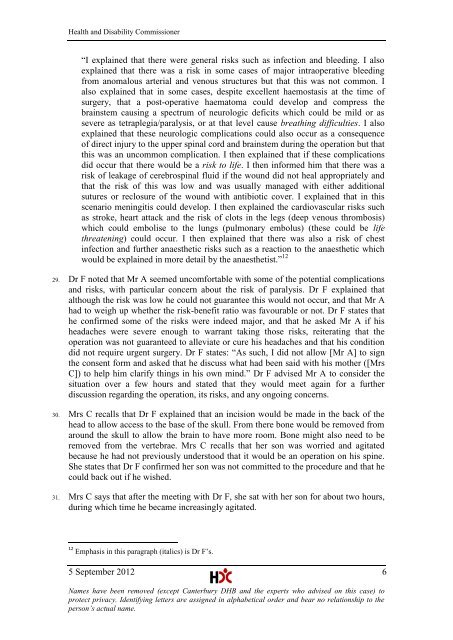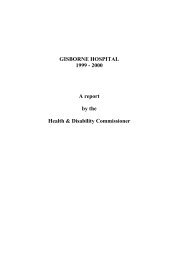09HDC01565 - Health and Disability Commissioner
09HDC01565 - Health and Disability Commissioner
09HDC01565 - Health and Disability Commissioner
Create successful ePaper yourself
Turn your PDF publications into a flip-book with our unique Google optimized e-Paper software.
<strong>Health</strong> <strong>and</strong> <strong>Disability</strong> <strong>Commissioner</strong><br />
―I explained that there were general risks such as infection <strong>and</strong> bleeding. I also<br />
explained that there was a risk in some cases of major intraoperative bleeding<br />
from anomalous arterial <strong>and</strong> venous structures but that this was not common. I<br />
also explained that in some cases, despite excellent haemostasis at the time of<br />
surgery, that a post-operative haematoma could develop <strong>and</strong> compress the<br />
brainstem causing a spectrum of neurologic deficits which could be mild or as<br />
severe as tetraplegia/paralysis, or at that level cause breathing difficulties. I also<br />
explained that these neurologic complications could also occur as a consequence<br />
of direct injury to the upper spinal cord <strong>and</strong> brainstem during the operation but that<br />
this was an uncommon complication. I then explained that if these complications<br />
did occur that there would be a risk to life. I then informed him that there was a<br />
risk of leakage of cerebrospinal fluid if the wound did not heal appropriately <strong>and</strong><br />
that the risk of this was low <strong>and</strong> was usually managed with either additional<br />
sutures or reclosure of the wound with antibiotic cover. I explained that in this<br />
scenario meningitis could develop. I then explained the cardiovascular risks such<br />
as stroke, heart attack <strong>and</strong> the risk of clots in the legs (deep venous thrombosis)<br />
which could embolise to the lungs (pulmonary embolus) (these could be life<br />
threatening) could occur. I then explained that there was also a risk of chest<br />
infection <strong>and</strong> further anaesthetic risks such as a reaction to the anaesthetic which<br />
would be explained in more detail by the anaesthetist.‖ 12<br />
29. Dr F noted that Mr A seemed uncomfortable with some of the potential complications<br />
<strong>and</strong> risks, with particular concern about the risk of paralysis. Dr F explained that<br />
although the risk was low he could not guarantee this would not occur, <strong>and</strong> that Mr A<br />
had to weigh up whether the risk-benefit ratio was favourable or not. Dr F states that<br />
he confirmed some of the risks were indeed major, <strong>and</strong> that he asked Mr A if his<br />
headaches were severe enough to warrant taking those risks, reiterating that the<br />
operation was not guaranteed to alleviate or cure his headaches <strong>and</strong> that his condition<br />
did not require urgent surgery. Dr F states: ―As such, I did not allow [Mr A] to sign<br />
the consent form <strong>and</strong> asked that he discuss what had been said with his mother ([Mrs<br />
C]) to help him clarify things in his own mind.‖ Dr F advised Mr A to consider the<br />
situation over a few hours <strong>and</strong> stated that they would meet again for a further<br />
discussion regarding the operation, its risks, <strong>and</strong> any ongoing concerns.<br />
30. Mrs C recalls that Dr F explained that an incision would be made in the back of the<br />
head to allow access to the base of the skull. From there bone would be removed from<br />
around the skull to allow the brain to have more room. Bone might also need to be<br />
removed from the vertebrae. Mrs C recalls that her son was worried <strong>and</strong> agitated<br />
because he had not previously understood that it would be an operation on his spine.<br />
She states that Dr F confirmed her son was not committed to the procedure <strong>and</strong> that he<br />
could back out if he wished.<br />
31. Mrs C says that after the meeting with Dr F, she sat with her son for about two hours,<br />
during which time he became increasingly agitated.<br />
12 Emphasis in this paragraph (italics) is Dr F‘s.<br />
5 September 2012 6<br />
Names have been removed (except Canterbury DHB <strong>and</strong> the experts who advised on this case) to<br />
protect privacy. Identifying letters are assigned in alphabetical order <strong>and</strong> bear no relationship to the<br />
person’s actual name.
















